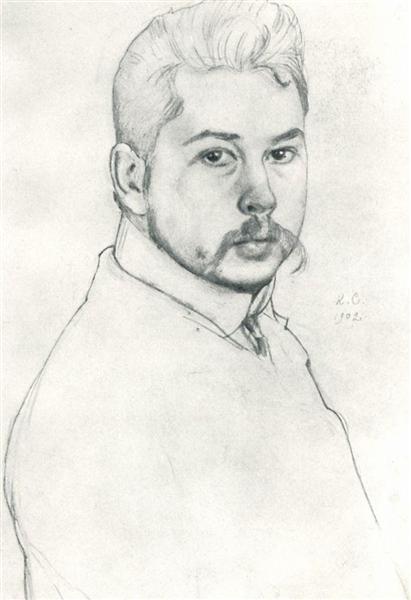説明
Konstantin Somov's painting "Self-Portrait" (1902) is a work that not only reflects the artist's identity, but also encapsulates the distinctive features of a period when symbolism and modernism were beginning to intertwine in the visual arts. A central figure in Russian art, known for his membership in the "Mundus" Movement, Somov manages in his self-portrait to convey a mix of introspection and elegance that invites the viewer to explore both the figure of the author and the cultural context of early 20th-century Russia.
Visually, the self-portrait is presented with careful attention to composition and colour. Somov, with his deep, enveloping gaze, occupies the centre of the work, while at the same time placing himself in an environment that seems to be a reflection of his thoughts and emotions. The use of cool, subtle tones, from deep blue to soft yellow, indicates a mastery of colour that is characteristic of his style. The transitions of light and shadow lend a psychological depth to the work, suggesting a rich and complex inner life. The restrained yet harmonious palette not only enhances the figure of the artist, but also infuses an air of melancholy and contemplation into the surrounding environment.
In the background, the deployment of decorative patterns, which hark back to Art Nouveau influences, creates a dreamlike atmosphere that reinforces the introspective nature of the portrait. This use of negative space and contrasting textures invite the observer to immerse themselves in the dialogue between the artist and his surroundings, where each visual element seems to have an intrinsic meaning. Somov, through his stylization, does not only portray himself, but also expresses a sense of belonging to an aesthetic ideal of his time.
It is remarkable how the artist's presence in the work can be interpreted as a reflection of personal narrative in a period marked by the search for new identities and forms of expression. Somov, who often incorporated elements of mythology and symbolism into his work, achieves in this self-portrait a balance between himself and the cultural influences that surrounded him. At the same time, his clothing, which combines an air of formality with an almost bohemian negligence, suggests an artist conscious of his role in the art world, but at the same time, an individual who feels distant from social conventions.
Somov’s approach to self-portraiture can also be seen as an exploration of the duality of being. In his gaze, there is a mix of confidence and vulnerability that becomes a mirage of the artistic spirit: a desire for connection with the outside world, but also a deep longing for introspection. This self-portrait, despite the simplicity of its subject matter, hides layers of meaning that reflect the uncertainties and aspirations of a generation of artists navigating the complexities of emerging modernity.
By placing Self-Portrait within the broader context of his work and art history, it becomes clear that Konstantin Somov does not merely perpetuate himself, but becomes a vehicle for expressing the zeitgeist of his era. His ability to combine ornamental beauty with emotional depth continues to resonate in our contemporary art appreciations, making this work a timeless testament to the relationship between artist and world.
KUADROS ©, a famous painting on your wall.
Hand-made oil painting reproductions, with the quality of professional artists and the distinctive seal of KUADROS ©.
Painting reproduction service with satisfaction guarantee. If you are not completely satisfied with the replica of your painting, we will refund 100% of your money.

